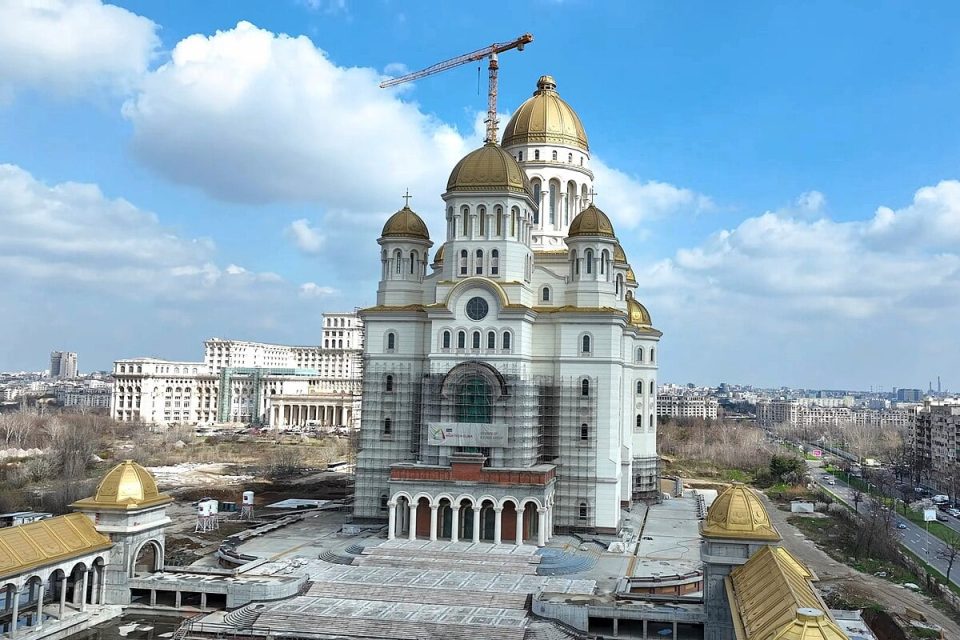
The biggest Orthodox church in the world is being built in Bucharest, Romania and is expected to open in 2025.
The People’s Salvation Cathedral at a height of over 130 meters will become the future seat of the Romanian Orthodox Church and the tallest Orthodox structure in the entire world.
It will be some 13 meters taller than the second-placed St. Peter and Paul Cathedral in Russia’s St. Petersburg, and the largest Orthodox structure by floor space. Situated behind the Palace of Parliament, this will make it 50 meters taller than the Palace, and will help to make the cathedral an iconic landmark in the city.
It will have the largest collection of church mosaics in the world (interior decoration) when it is completed, having about 18,000 square meters, including the mosaic of the altar at about 3,000 square meters. The mosaic contains glass tesserae from Venice, and Carrara stone from Pietrasanta, Italy.
The building will be able to welcome around 6,000 worshippers and a church choir of 1,000. It will have four elevators, and will also feature a 25-ton bell which, could be heard at a distance of over 20 kilometers.

Patriarch Bartholomew consecrated the world’s biggest Orthodox Church
The cathedral was consecrated on 25 November 2018 by the Ecumenical Patriarch of Constantinople Bartholomew, Patriarch Daniel of Romania and Metropolitan Chrysostomos of Patras from the Greek Orthodox Church. On the same day as the consecration, the very first church service of the cathedral took place and was led by both Patriarch Bartholomew and Patriarch Daniel.
A reported 200 million euros ($216 million) have been spent on the project thus far, with most of the money coming from public funds, and around a quarter from donations.
Supporters of the mega project point out its potential draw as a tourism attraction and a site for future pilgrimages by Orthodox faithful from across the globe, in addition to its spiritual purpose as a church tending to the needs of its faithful in what remains a deeply religious country.
Per the Pew Research Center, the population of Romania was about 86 percent Orthodox Christian in 2017. The Center also found Romania to be the most religiously devout among 34 surveyed countries in Europe, with 50 percent of the population stating that religion played a very important role in their lives, and the same population claiming to attend religious services at least once a month.

Critics slam “pharaonic” project
Critics have called the construction “pharaonic” and comparable to the megalomania of Ceausescu, the last communist leader of Romania.
Architectural historian Valentin Mandache is scathing about the cathedral project, telling Radio Free Europe recently that the landmark was an eyesore akin to communist-era constructions that lacked “any kind of aesthetics.”
The Romanian claimed the building is an example of his country’s “corruption, excess populism, preference for strongmen and dictatorships, and, essentially, cultural backwardness.”
Sociology professor Gelu Domenica, of the University of Bucharest, highlighted that many Romanians still survive on around 3 Euros a day at the time the project was being built, and that some parts of the capital city Bucharest remained without functional running water.
He concluded: “It seems that the authorities are more interested in investing in our well-being in heaven rather than here on Earth.”
Another criticism was put forward by MP Rina Sernia, who argued that the huge contribution to the project from public funds represented an unwelcome infringement of the separation of church and state, a claim that has validity given Romania’s status as an officially secular country. He added that the church’s construction should have been financed, above all, via church funds and charitable contributions, rather than via funding from the state.
Despite the significant cost, some believe that the People’s Salvation Cathedral represents a distinctive Romanian identity, a symbol that connects to a vital part of their cultural heritage. It stands out against the backdrop of a skyline dominated by reminders of the country’s authoritarian past.
Watch the following video by Mega Projects:
